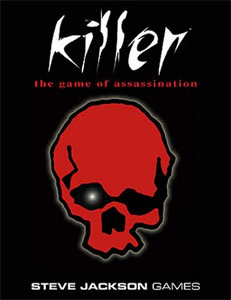 As I’ve discussed previously, Technoir features a conflict-resolution system in which players push adjectives onto other characters. For example, instead of making an attack roll with your machine gun to inflict hit point damage, you instead use your Shoot verb to apply the adjective of riddled to the target.
As I’ve discussed previously, Technoir features a conflict-resolution system in which players push adjectives onto other characters. For example, instead of making an attack roll with your machine gun to inflict hit point damage, you instead use your Shoot verb to apply the adjective of riddled to the target.
In the rules as written, positive and negative adjectives “can be applied to a character directly – representing her physical or psychological state – or to an object belonging to a character – representing its physical condition or the states of its electronics and software”. When applying the latter, you’re supposed to draw a line from the adjective to the piece of equipment being affected. Some of the former might only apply to a particular part of the body; if so, that should be indicated in parentheses next to the adjective. (For example, broken (arm).)
RELATIONSHIP ADJECTIVES
There is also one other type of adjective in the game: The permanent, locked relationship adjectives which describes how a PC feels about their connections. (These adjectives act “as positive adjectives when the protagonist is helping or defending that character, they act as negative adjectives if she acts against that character”.)
What I would like to propose is a slight conceptual and mechanical shift in how relationship adjectives are handled throughout Technoir.
1. A relationship adjective specifically refers to any adjective which describes the connection between two characters.
2. When you apply a relationship adjective to a character, you specify which character they have that relationship with. The adjective describes the target character’s relationship with that character; it does not necessarily describe the character’s relationship with them.
(You can already apply an adjective like trusting. What I’m saying is that you should specify who, exactly, the character trusts. For example, trusting (Paul) or affectionate (Cyndi). This would mean that they’re trusting of Paul or affectionate of Cyndi; it wouldn’t necessarily means that Paul trusts them or Cyndi likes them.)
3. If you want a relationship adjective to describe their relationship with multiple people – for example, if you want them to be trusting of both you and your friends – then you need to use the rules for multiple targets: You need to have an adjective or tag that justify the application and you need to discharge a Push die (that is not rolled as part of the dice pool) to pay for the attempt.
Pushing relationship tags that describe relationships with multiple people onto multiple targets costs two Push die (one for multiple relationships; one for multiple targets).
(For example, if you want to make an entire Cyn Set gang loyal to Saito International, you’d need to spend one Push die to affect all the members in the gang and a second Push die because Saito International represents a large group of people. However, if you just want the leader of the gang to feel loyal to the corporation, that would only cost one Push die. Similarly, if you want the whole gang to feel loyal to a particular representative of the Saito International, that would also only cost you one Push die.)
4. Relationship adjectives generally act as negative adjectives when you act against the character you have a relationship with and positive adjectives when you’re helping or defending that character. Some exceptions may exist.
5. In general, relationship adjectives work just like any other adjective. If someone is fleetingly trusting of a character, they’ve been momentarily persuaded to believe their story. If that same adjective is made sticky, on the other hand, then they’ll keep swallowing the character’s bullshit for a long time.
If a relationship adjective is locked onto a protagonist, however, the character it describes automatically becomes a connection. (Somebody is saying “this guy is of major importance to this protagonist” and that needs to be respected.) This means they can be hit up like any other connection, added to the plot map, and so forth. (The GM can prep customized connection tables for the new connection; use them to replace a connection who has been killed or otherwise removed from play; or even make them the seed for a new or overlapping transmission. Alternatively, the GM can just use the master table for the connection whenever the nouveau connection is hit up.)
6. Of course, as with any other adjective, you still need to establish the proper vector for applying the adjective.















